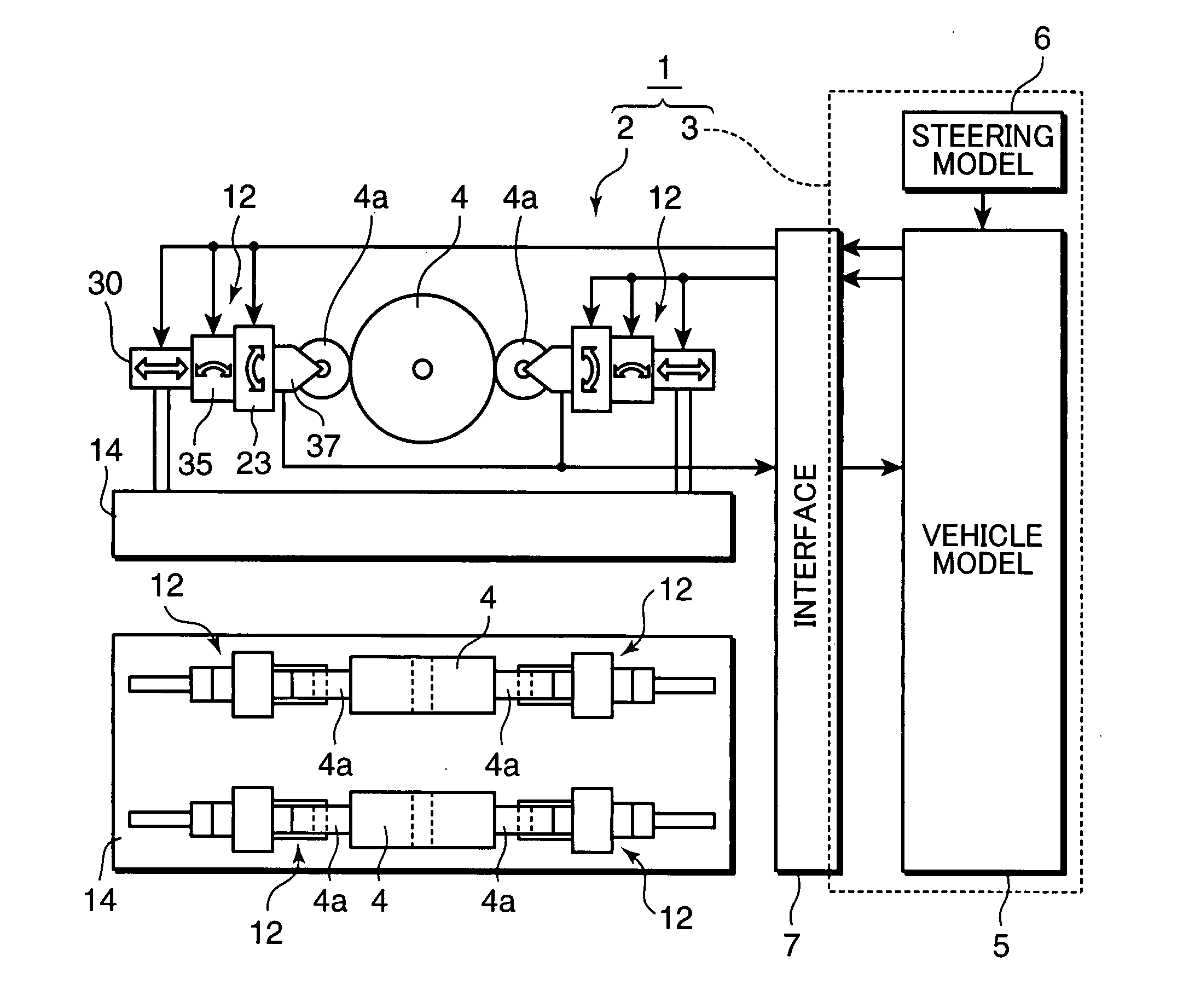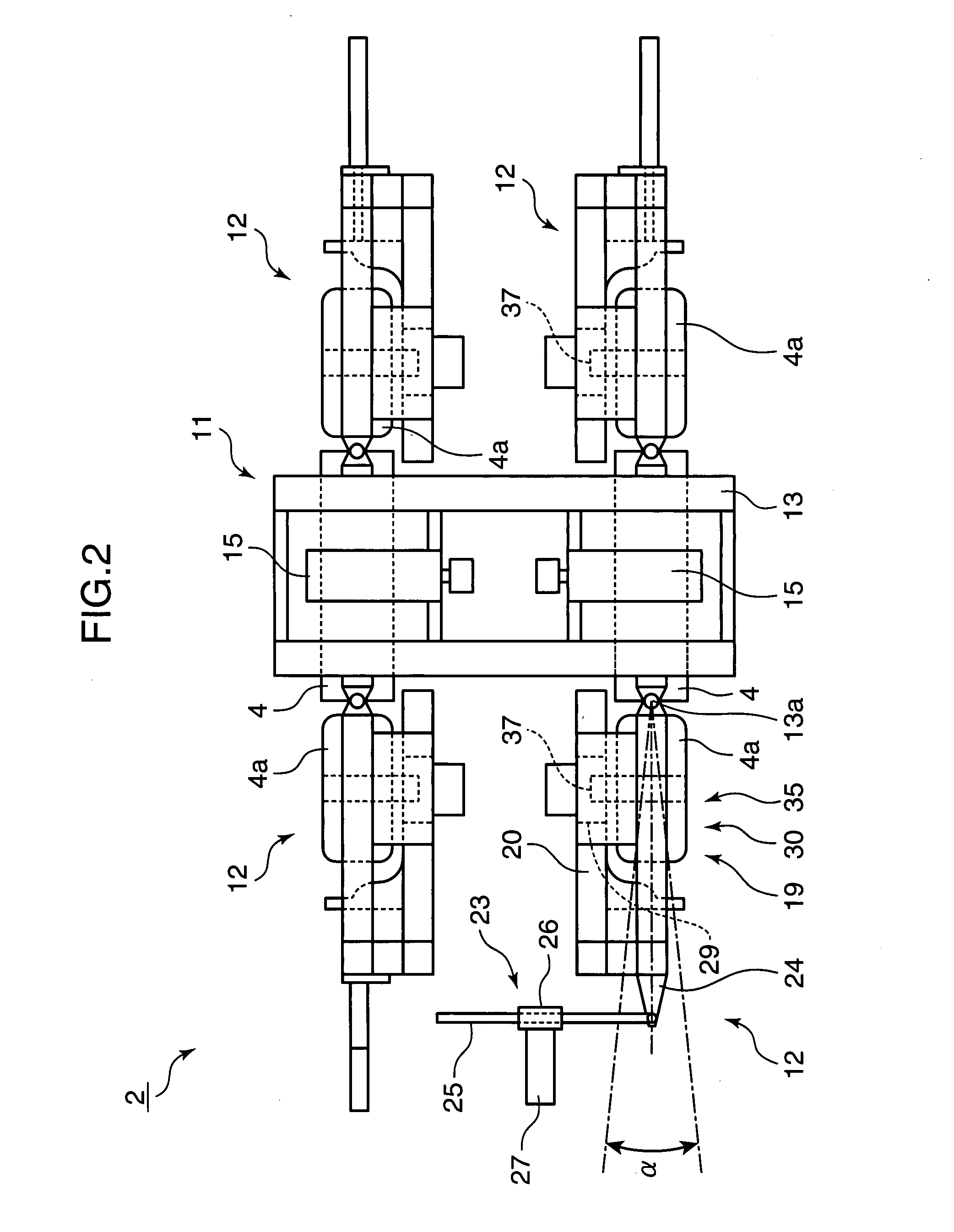Tire Hil Simulator
a technology of vehicle models and simulators, applied in the field of tires hil, can solve the problem that the camber angle generated by the vehicle model when it is three-dimensionally considered cannot be reproduced in a testing apparatus
- Summary
- Abstract
- Description
- Claims
- Application Information
AI Technical Summary
Benefits of technology
Problems solved by technology
Method used
Image
Examples
second embodiment
[0083]FIG. 8 and FIG. 9 show the present invention. In this embodiment, as shown in FIG. 8, each tire attachment portion 12 described above is provided with a braking force actuator 38. This braking force actuator 38 is adapted for imparting a braking force to the tire 4a, and is connected to each tire 4a at a position near the side-force measuring device 37. As shown in FIG. 9, each tire attachment portion 12 is connected via the interface 7 to the vehicle model 5.
[0084] In this embodiment, braking forces to the front wheels and the rear wheels which are derived from the vehicle model 5 are inputted as command values in the braking force actuator 38 to thereby give the braking force derived from the vehicle model 5 to each tire 4a. Consequently, the vehicle model 5 is imparted with a rotational motion in the pitching direction, thus enabling to generate a simulation in which a braking force is given.
third embodiment
[0085] the present invention is shown in FIG. 10 and FIG. 11. In this embodiment, as shown in FIG. 10, a drive unit 15 is provided with a speed detector 40 for detecting a speed at which the mimic road surface body 4 is driven. This speed detector 40 and the drive unit 15 are connected, as shown in FIG. 11, via the interface 7 to the vehicle model 5.
[0086] In this embodiment, since there is provided the means for measuring and controlling the drive speed of the mimic road surface body 4 (in the figure's example, the rotational speed of the drum which constitutes the mimic road surface body 4), the drive speed derived from the vehicle model 5 can be given to the mimic road surface body 4. This enables to generate a simulation in which the drive speed of the mimic road surface body 4 is changed.
fourth embodiment
[0087] the present invention is shown in FIG. 12 and FIG. 13. In this embodiment, as shown in FIG. 12, each drive unit 15 is provided with a driving torque detector 41 for detecting a torque by which the mimic road surface body 4 is driven. In this embodiment, a motor capable of controlling the rotational speed of the drum of the mimic road surface body 4 serves as the driving torque detector 41. As shown in FIG. 13, the driving torque detector 41 is connected via the interface 7 to the vehicle model 5. The vehicle model 5 has, as one of parameters, a rolling resistance which is derived based on a driving torque detection value outputted from the driving torque detector 41.
[0088] In this embodiment, a rolling resistance force is calculated based on the drum driving torque detected by the driving torque detector (or the motor) 41. This rolling resistance force is inputted in the vehicle model 5, thus enabling to generate a simulation in consideration of the effect of the rolling resi...
PUM
 Login to View More
Login to View More Abstract
Description
Claims
Application Information
 Login to View More
Login to View More - R&D
- Intellectual Property
- Life Sciences
- Materials
- Tech Scout
- Unparalleled Data Quality
- Higher Quality Content
- 60% Fewer Hallucinations
Browse by: Latest US Patents, China's latest patents, Technical Efficacy Thesaurus, Application Domain, Technology Topic, Popular Technical Reports.
© 2025 PatSnap. All rights reserved.Legal|Privacy policy|Modern Slavery Act Transparency Statement|Sitemap|About US| Contact US: help@patsnap.com



